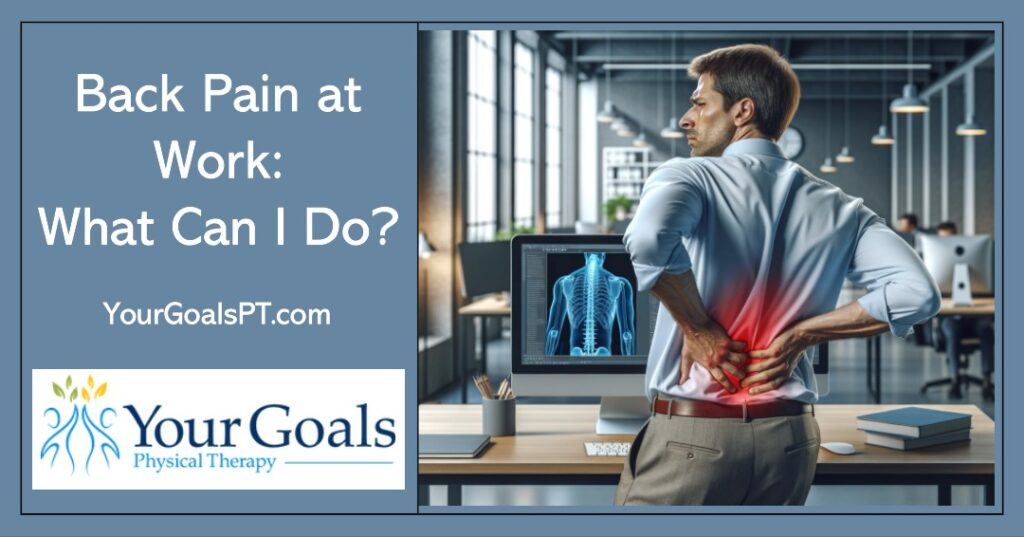
A comfortable and ergonomic workspace doesn’t just look nice. It’s there to take care of your body and overall well-being. Keeping good posture and adding ergonomic adjustments to your workspace can make a huge difference in reducing back pain and improving your overall health and productivity.
We’ll get into ergonomics in a moment, but first, here’s a real-world story of pain in the workspace. A person who’s not yet aware of ergonomics.
John works in a fast-paced, restless workplace, sitting at a computer in an office every day.
He finds himself wrestling with unrelenting upper back pain that seems to grow more severe as the days pass.
This pain only started out as a minor annoyance. Now, it’s chronic. A spike of hurt down his back stiffens him. He frequently catches himself distracted by sharp twinges or dull aches. Every single time, it intensifies, and stiffens his back.
The pain diverts his attention. Every day, John perches himself at the computer, hoping to complete his obligations as normal. Try as he might, he only completes half the work he wants and needs to. The rest of his time? Dominated by his pain.
No longer does John simply “perform” his daily tasks. He endures them. Even getting up and walking feels like a chore. His concentration breaks. His productivity, way down. John is fatigued, ineffective, and miserable, and at risk of being fired.
Outside his office, the repercussions of his back pain become even more pronounced. Activities that John once pursued with vigor and enthusiasm, like hiking on weekends, playing catch with his kids, or running, have become strenuous, if not outright impossible. Correction – he actually can’t run outside of work. The joy & leisure he cherishes is now nearly gone.
“What the heck do I do!?”
John tries to recover in many ways.
A constant cycle of trial and error. Each failed attempt only leaves John more frustrated. Now, he wonders if there even is a solution that lasts…
Let’s pause for a moment:
Ergonomics is the science of designing and arranging objects in harmony with the human body. Its goal is to optimize the interaction between people and their environment, for better comfort, productivity, and overall well-being.
By making these adjustments, John could reduce strain on his body, rebuild proper posture, align his muscles, and ultimately, massively help his back pain.
Ergonomics creates an ideal fit between a person and their work environment. It takes into account factors such as body mechanics, equipment design, and workflow to minimize physical stress and improve productivity.
The significance of ergonomics in the workplace cannot be overstated. Work on computers can bring the misery of a sedentary lifestyle if you don’t tackle it properly. Worse — you could develop further musculoskeletal disorders.
When your workspace is ergonomically optimized, you are less likely to experience discomfort, develop worse back pain, and can prevent injuries, and best of all, prevent absenteeism.
Here’s some simple yet key ergonomic adjustments that can work wonders for your posture & back:
John discovers an article like this about ergonomics. He gets to thinking. He raises and lowers his desk until it’s more comfortable. Finally, something reasonable.
But that still doesn’t help the back recover. What does John do next?
Here’s a handy step-by-step procedure you can take to set up your office space for better ergonomics, to prevent back pain, and if you do have it, make it at least somewhat easier on your back.
Neglecting your health is the sure way to not be able to show up for work. If John was healthy and aware, and he just needed his back to handle the grind, he’d need to treat his body well – as a preventative mesaure. Consider these simple activities:
Not enough breaks? Ask your boss if it’s okay to do it every hour! Regular breaks are a great tool for a healthy body and reducing the risk of back pain.
Prolonged sitting can stiffen you, stress you, and seriously hamper your overall well-being. Taking a short break every hour allows you to stand up, stretch, breathe, relax, and move around, relieving pressure on your back and helping blood circulation.
Plus, if you stare at a computer too long, it’s hard on your eyes. Take a 20-second break from the screen every 20 minutes. It does a great deal good for your eyesight.
Simple stretching exercises or micro-movements can provide significant relief from back pain. Incorporating exercises such as shoulder rolls, neck stretches, and gentle twists can help alleviate muscle tension and improve flexibility. These exercises can easily be performed at your desk, ensuring minimal disruption to your work routine.
Be careful not to do the wrong exercises, or the right exercises wrong – especially if you don’t know the root cause of your back pain.
Ensure that your chair offers proper lumbar support and is adjusted to the correct height and angle. Additionally, position your monitor at eye level and use a keyboard and mouse that allow for comfortable, natural wrist positions. We can’t restate enough: Ergonomics makes computer work easy on the back!
Unfortunately, John hasn’t prevented the back pain, so it’s too late to try to stretch or break. His back still can’t handle it. The pain nags him chronically.
Now, he’s frustrated. His pain still persists even after adjusting the desk. He’s cranking the handle back and forth, in little micro-increments, and his efforts are in vain.
He’s about to snap from the pressure.
“Is there any hope?”
You’re not alone. The root cause of back pain is individual. You can’t try to treat the symptoms. It can be a different muscle or bone that’s causing the worrisome, spiking, stiffening feeling.
Enter Dr. Molly at Your Goals Physical Therapy. She sees people like John in her Cypress, Texas office every week.
Dr. Molly’s secret sauce is finding the root cause of your pain (down to the specific muscle and bone) to help you come up with a comprehensive program to end your back pain.
Now, you’re not just suppressing warning signs from your body’s pain receptors. You’re correcting structural damages inside your body. You read that right – structural damages, from stress to improper posture. Your body is made in a certain way, and if it’s out of order, chronic pain is the warning signal.
Hence, when you restore what’s inside – tissue, muscle & bone – to its natural state, you’ll experience long-term relief. Dr. Molly’s personalized treatment protocols are designed to do just that.
Let’s say John gets a consultation with Dr. Molly. After Molly analyzes his pain and creates a custom program, John follows it step by step.
A few sessions later, he’s back to normal. He’s flying! He’s running again, enjoying quality time with his kids, and the moment he walks through the door at work, his boss’s eyes light up. “Is that really John!?” Hours of productivity, regained, with a perfectly organized computer desk.
John can use the steps in this guide to keep his workspace ergonomic. He even buys his own equipment for this purpose. Ah, yes, this is the life.
How about working from home? While yes you do have certain freedoms the regular workspace doesn’t, you’re still probably plopping yourself in a chair to work online and attend Zoom meetings. And working long hours from home in this way is a sure recipe for — you guessed it — back pain.
A work-from-home environment can still give you back discomfort from poor posture, lack of movement, and a lack of ergonomic adjustments.
The great news? Your home gives you freedom of ergonomics! Depending, of course, on the furniture and objects you have at hand, you can rearrange a great deal to alleviate your back pain and make your WFH workstation a safer, more comfortable and healthier one.
Here are are specific ergonomic adjustments you can make:
With these ergonomic adjustments, you can minimize the risk of back pain and create a more conducive and comfortable work environment at home. Now you can be your own boss of workplace safety — at home!
By now, you understand ergonomics has REAL benefits. It’s a great & highly effective tool to reduce back pain in the workspace.
Next time you punch in and step into the office, ask yourself: “Hmm. How can I rearrange all my stuff?” Chances are great that rearranging your stuff — in an exact way — can make work life comfortable and pain-free.
Recapping the ergonomic adjustments we have discussed:
Think of the age-old motivational quote: “Do something today that your future self will thank you for.”
These simple adjustments today will determine your long-term health and productivity. Your back will thank you. Heck, if you take pride in your job and this means you don’t have to miss a day anymore, your boss could even give you a raise!
So do these simple adjustments and you can significantly reduce the risk of back pain and related discomfort.
If you DO have back pain, be careful not to perform non-prescribed exercises. They can worsen your back pain if you don’t know the root cause. Remember what we wrote earlier about structural damage. See a licensed medical practitioner (like Dr. Molly, a physical therapist) for personalized advice before undergoing treatment.
Remember, taking care of your health should always be a top priority. Invest time and effort into creating an ergonomic workspace. You’ll be grateful you did. You’ll reap the benefits of a comfortable, pain-free work environment.
DISCLAIMER: This article is for educational and informational purposes only and is not to be substituted for medical advice. We believe the appropriate exercises and strategies to fix posture & relieve pain are unique to every person suffering back pain. If you want to discover what those are for you, and you are in the Cypress, Texas area, please contact us to request a consultation or inquire about cost & availability.
We help active adults end their aches and pain, so they can reclaim their favorite recreational activities and live life to the fullest.

MEDICAL DISCLAIMER:
All information on this website is intended for instruction and informational purposes only. The authors are not responsible for any harm or injury that may result. Significant injury risk is possible if you do not follow due diligence and seek suitable professional advice about your injury. No guarantees of specific results are expressly made or implied on this website.